MARIANI’S
Virtual Gourmet
March 11, 2018
NEWSLETTER

❖❖❖
IN THIS ISSUE
STAYING PUT IN BARBADOS
BY JOHN MARIANI
NEW YORK CORNER
GABRIEL KREUTHER
By John Mariani
NOTES FROM THE SPIRITS LOCKER
IRISH WHISKEY SALES SOAR
By John Mariani
❖❖❖
STAYING PUT IN BARBADOS
BY JOHN MARIANI
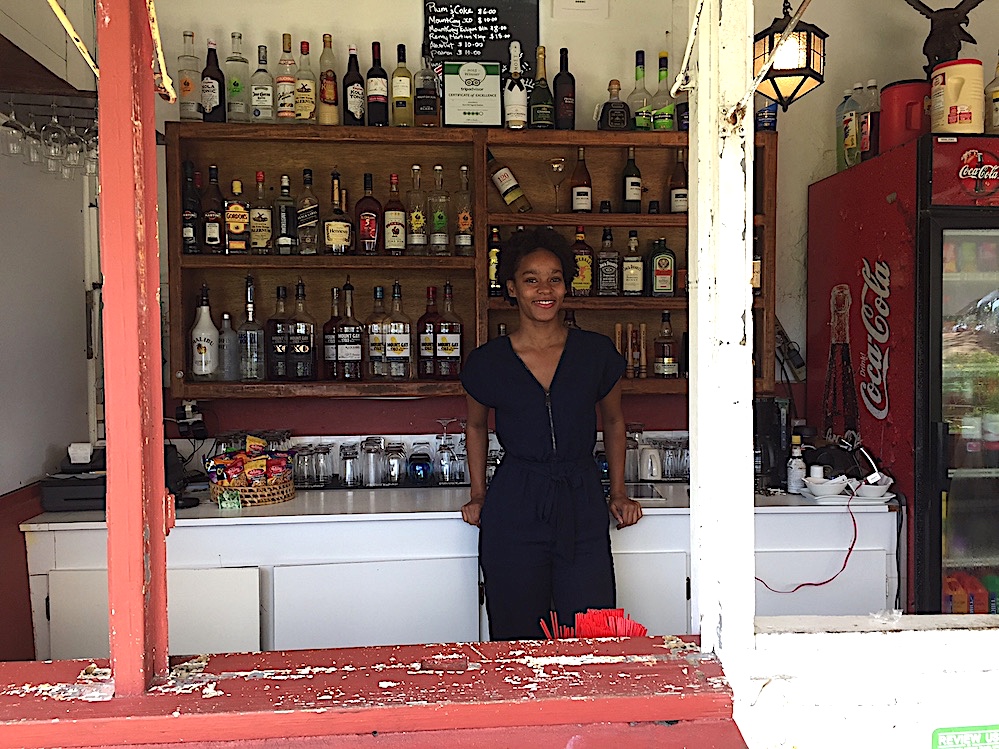
Photo by John Mariani
Largely
unaffected by hurricanes Irma and Maria,
Barbados remains very much open to tourism
this winter and spring, and for that reason
bookings may quickly leap among those seeking
a Caribbean vacation this year.
(Incidentally,
the Barbados dollar is worth half the U.S.
dollar, so don’t be too astonished by the prices
below.)
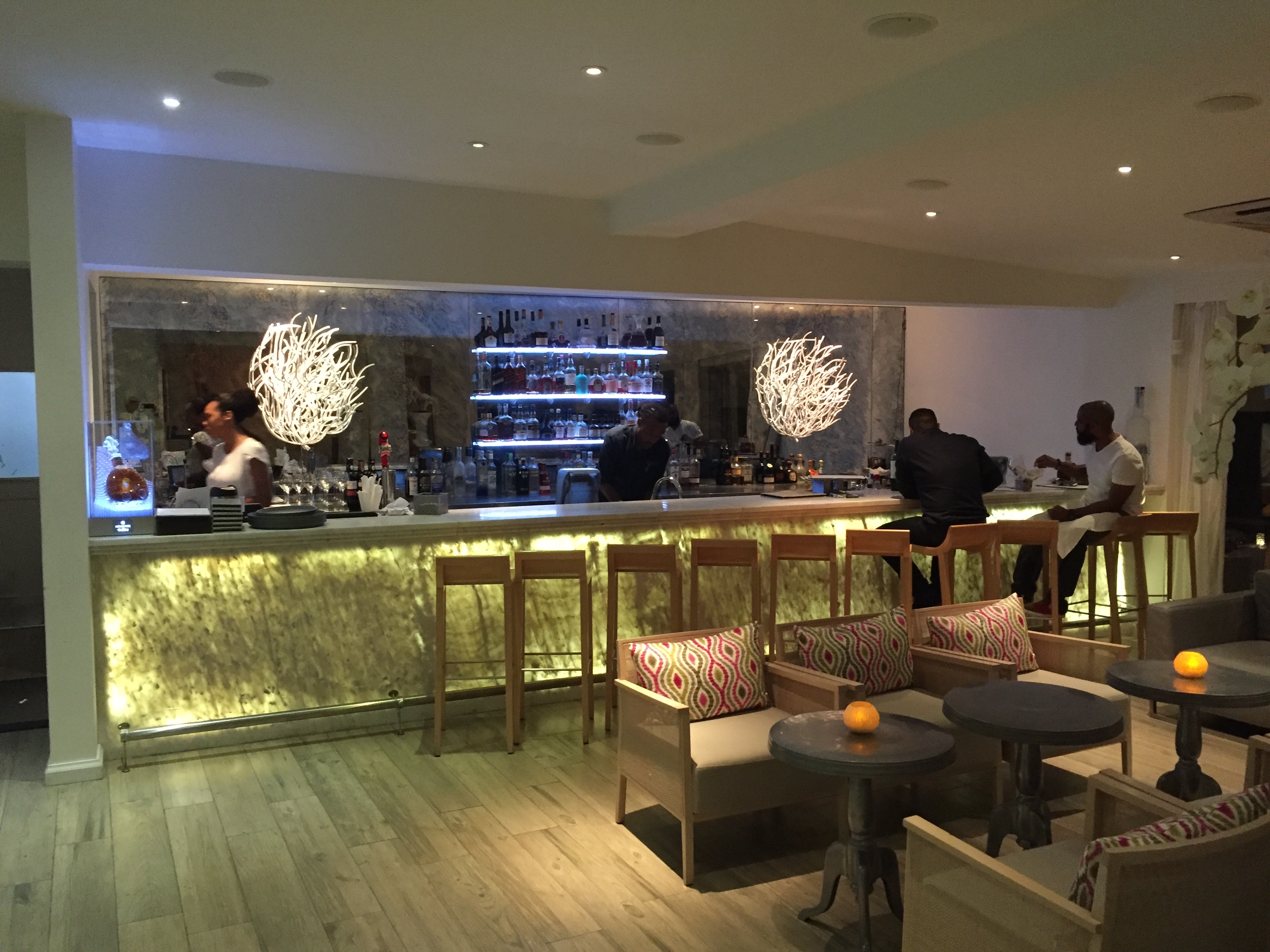 CINCIN
BY THE SEA
CINCIN
BY THE SEA
Prospect
Road, Prospect
246-629-4557
CinCin is easily one of the
more elegant restaurants to open recently on the
island. Windswept, of course, the dining room has
clean, minimalist lines and white sand colorations
accented by upholstered pillows with native
motifs. The sleek, comfortable bar (left) has
become very popular, and they stock a wide array
of spirits and wines. The piped-in music, however,
is dreadful stuff.
CinCin has a more international flavor than most
places on the island, including not-to-miss pork
buns and shrimp buns ($27) and a crisp vegetable fritto
misto ($27). More island-based are the very
good crabcakes with pickled mango and a nicely
spied rémoulade ($37).
You never know each morning what the sea might
bring in terms of seasonal fish in the Caribbean,
so I respect CinCin’s not claiming to have wahoo
or grouper every night of the week. Whatever the
day’s fish, it can be pan-fried, served on leek
and potato purée with almond butter and a
vegetable ragôut ($59) or as fillets fried and
accompanied by artichoke, roasted pepper,
asparagus, and a tomato and mushroom salad ($59).
THE
SANDPIPER HOTEL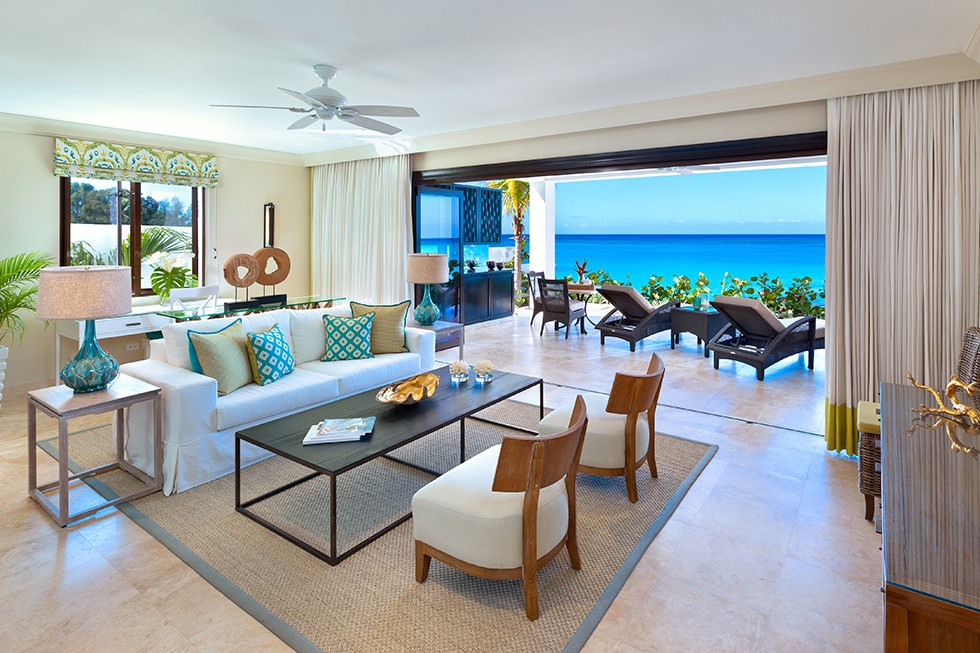
St. James
246-422-2251
It’s
not easy to see The Sandpiper from the road
because by design it is enwrapped in a
well-manicured jungle of palms and tropical flora
that leads to a white sand west coast beach
beyond. The pathways meander through the grounds,
past a wooden deck and pool, and wildlife likes
nestling on the property. I even saw a small
mongoose on the outdoor patio of my suite, which
made me feel safe from the native snakes.
The resort was
built in 1970 by Brits Budge and Cynthia O’Hara,
and today their sons Patrick and Mark and a
daughter, Karen, run the place on the strength of
their own personalities and love for Barbados,
where they spent so much time growing up. Karen’s
husband, Wayne Capaldi and fellow Director and
General Manager, Russell Croney run the day-to-day
operations of The Sandpiper and get to know every
guest very quickly.
Much of the
charm of The Sandpiper is due to its seclusion and
the way it’s laid out the way Candyland
might be were it in the Caribbean.
PORT FERDINAND RETREAT
Port Ferdinand
246-272-2000
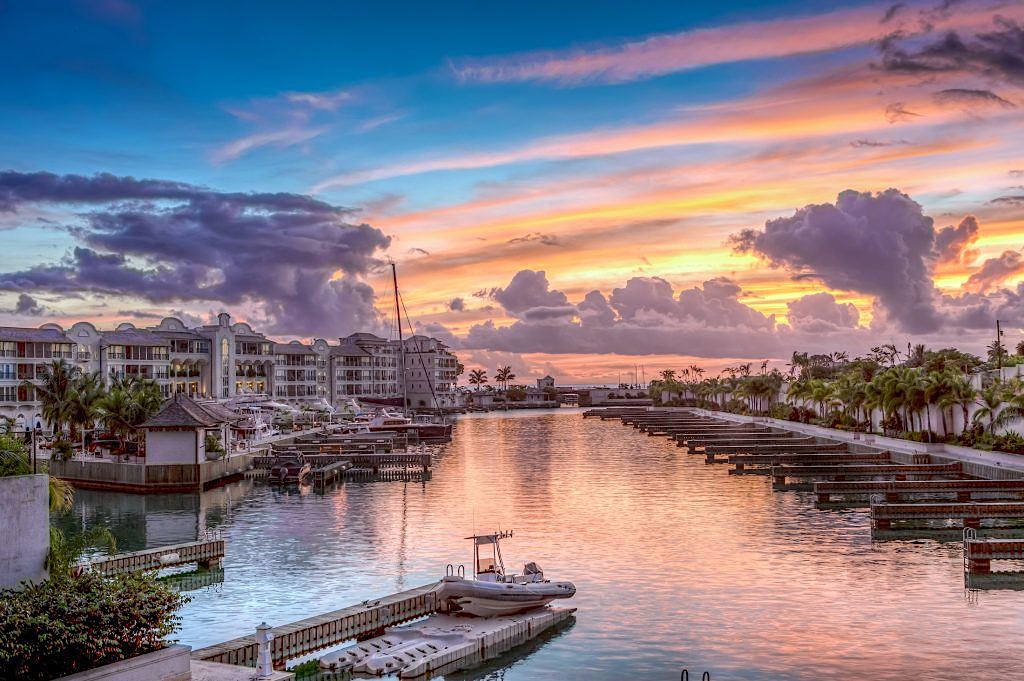
Port Ferdinand resort has the same
owners as the Saint Peter’s by the Bay and fits
snugly within the sheltered marina slip off Six
Men’s Bay that serves as much as a safe haven for
wildlife as it does for the fleet of yachts in
90-foot berths docked here. Even if Barbados was
to get hit by a hurricane, the marina is equipped
with a “floating wave attenuation system” designed
to prevent storm-driven waves from causing hull  or craft damage.
or craft damage.
All the homes here are as luxurious as any in the
island, with marble and limestone finishes, coral
detailing and excellent lighting throughout,
including a full kitchen open to the living room
overlooking the slip. Outdoors the Pool Island is
a quiet spot to swim or lie back with a piña
colada or rum punch in hand and let the sun work
its wiles.
The Quarterdeck Bar & Pizzeria
here serves light fare and pizzas, and you can
catch a water taxi that takes you along the coast
to Saint Peter's Bay's lagoon pool.
There is also an indoor Golf Simulator
where you can pretend to play 18 holes if you
haven’t access to the island’s regular courses.
The upscale restaurant on property is named
after Barbados’s latitude and longitude—13º 59º—where
Chef Kevin Shawcross has won as many accolades as
anyone on the island. There is even tableside
service. It’s a sumptuous menu with classic dishes
like a rich gratin of five onion soup with Comté
cheese ($25) and beef carpaccio with onion cream,
mustard leaf, aged parmesan and lemon ($45). When
available, red snapper comes with a fine seafood
chowder and a little smoked ham ($75), and, almost
always available, the sweet aromatic curry of
lobster with coconut rice, and purple basil ($105)
is one of the stand-outs here. For dessert I’ll go
for the mango and blueberry crumble ($22) or three
different chocolate preparations on one plate
($28). One of the favorites here is the Mount
Gay-rum infused and raisin studded ice cream
($11). A
service charge of 10 percent is added to your
bill.
There is a real sense of seclusion at the
resort, not least because the villas are well
spaced from each other, so that you could happily
hole up here for your entire stay and shed every
stress in your day-to-day life to point of
banishing all thought of them.
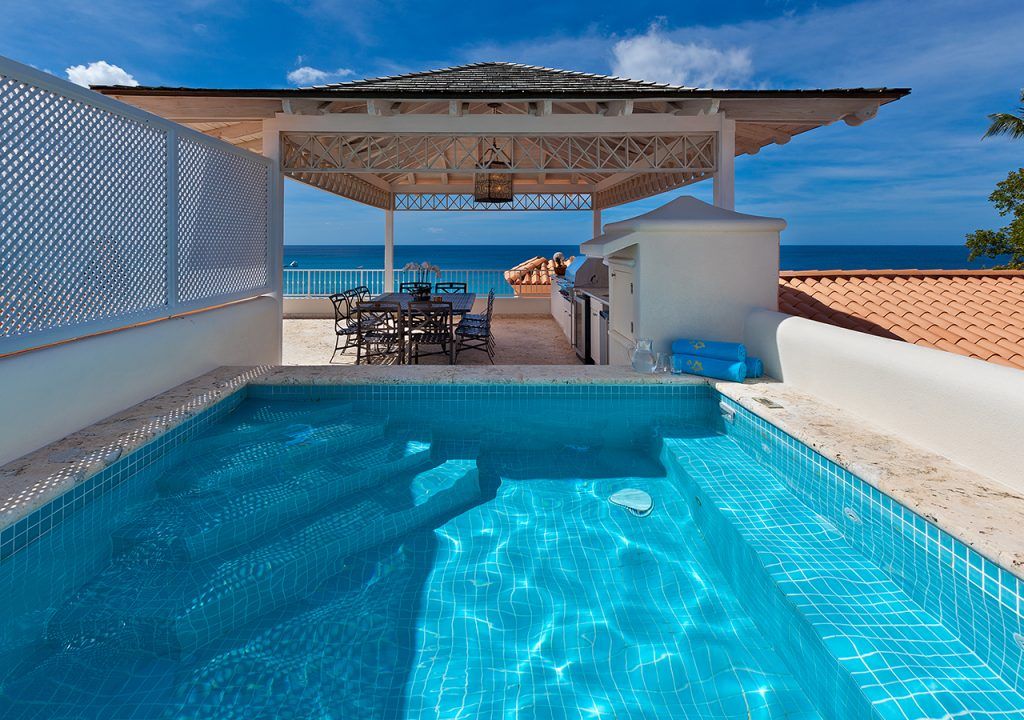 ST
PETER’S BAY LUXURY RESORT
AND RESIDENCES
ST
PETER’S BAY LUXURY RESORT
AND RESIDENCES
St.
Peter Parish
246-419-9602
Saint Peter’s Bay is
one of Barbados’s prime beaches, situated between
Speightstown and Holetown on the northwest coast,
and the St. Peter’s Bay Resort and Residences, on
four acres with 500 yards of beachfront, takes
full advantage of the natural beauty of the green
and sandy land and blue-hued sea.
All the rooms here are in private owned
villas--the management calls them “homes”—but
fortunately many of the individual owners rent
them out to tourists. All have two or three
spacious bedrooms with king, queen or twin beds
and fully equipped kitchen with
dishwasher and dryer;
you can also arrange through the concierge for a
cook to come to your room and prepare your meals.
The bathrooms are as large as many city
apartments’ living rooms, and each has a
Jacuzzi, The only surprise is the fake
flowers in the rooms!
The resort also has its own water taxi to
take you restaurants nearby and to the Port St.
Charles Yacht Club. On premises the al fresco Gazebo
Bar & Grill serves good Caribbean fare
like blackened mahi mahi sandwich with sweet
potato fries, as well as breakfast and children’s
menu.
CLIFF
BEACH CLUB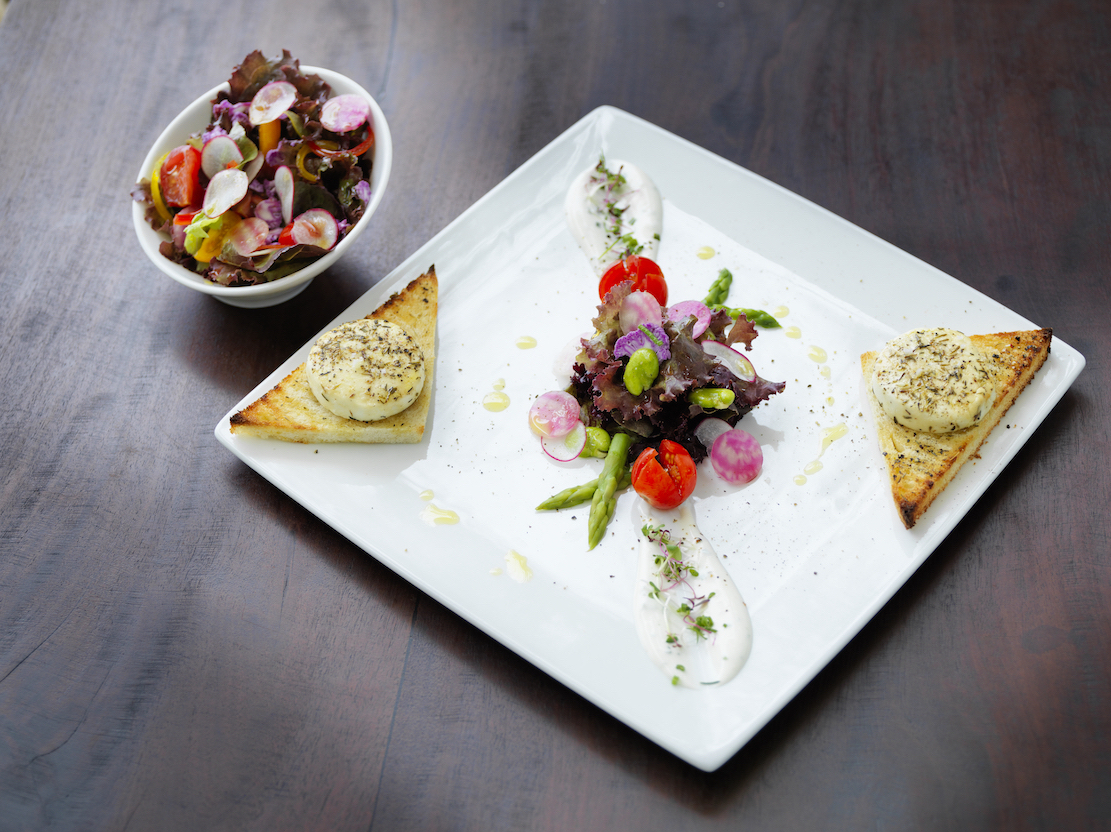
St. James
246-432-0797
Above
the Cliff Beach Club is the more luxurious dinner
venue called The Cliff, but I prefer the airy,
casual chic of The Club, set into the rocks that
rise above the west coast beach.
Chef Jeremy Dupire is doing an outstanding
job with an eclectic menu that is every bit as
pretty as it is delicious. He has
a very fine hand and shows finesse in dishes of a
quality you don’t often except to see in the
Caribbean, like his octopus carpaccio with a
citrus dressing, fruit and herbs ($50); chorizo-stuffed
squid in a pesto sauce with a confit of sweet
peppers $45); 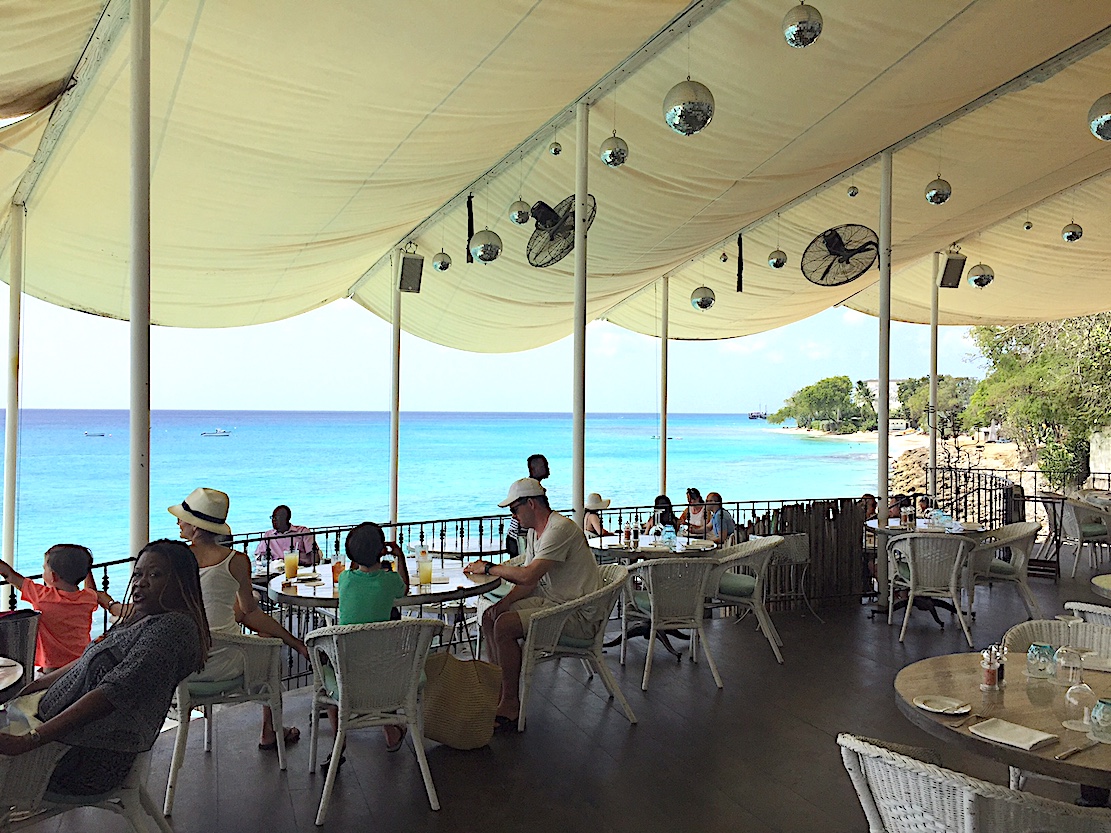 and goat’s
cheese croquette with grilled zucchini and sweet
peppers ($40).
and goat’s
cheese croquette with grilled zucchini and sweet
peppers ($40).
He also renders a spicy
lobster ($85) with aplomb, the rice cooked
impeccably, the lobster meat tender and sweet. He
applies the same careful technique to the fish and
chips with tartare sauce ($70), as well to the day’s
catch nicely seasoned and topped with a lace of
potatoes and onions set on deep green arugula in a
rich beurre blanc ($80).
I could return here
several times in a week and probably not exhaust
Dupire’s repertoire or imagination for stylish,
high-quality food. It’s a place to go to find
something always new and expressive of the chef’s
culinary passions.
CHAMPERS
WINE BAR & GRILL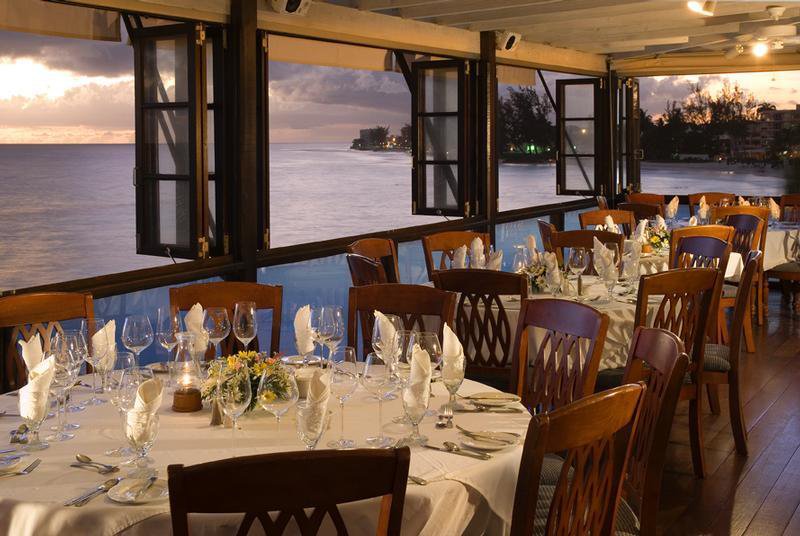
Skeetes Hill, Christ Church
246-434-3463
While
Champers has the same, balmy, wave-lapped
waterfront look so many other upscale restaurants
on Barbados do, it is uniquely the most colorful,
via walls of Caribbean artwork for sale, curated
by Veronica Comissiong. The restaurant staff is also
one of the most affably hospitable. From
the moment you are greeted by the cheery host, you
feel very warmly welcomed.
The menu is perhaps a
little too long for both lunch and dinner, but the
cooking is solid and often elaborate, from a
caramelized onion and goat's cheese tart with
toasted sunflower seeds finished with a beet
emulsion and roasted pepper essence ($22) to queen
scallops quickly pan-seared and served atop a
risotto cake with creamy leeks, finished with shiso
greens and a light saffron cream $39). There’s
coconut shrimp with chili sauce ($36.50) and a
very good crab au gratin ($36.50).
And those are just the
appetizers.
For main courses you should consider the
sautéed prawns in a Thai chili sauce and coconut
over jasmine rice ($68.50) or the seared ahi tuna
served on warm soba noodles with a ginger salad
accompanied by tempura vegetables and laced with
the wasabi mayonnaise and sweet miso dressing
($69.50).
 LONE
STAR BOUTIQUE HOTEL & RESTAURANT
LONE
STAR BOUTIQUE HOTEL & RESTAURANT
Mount Steadfast
246-629-0599
I
did not have a chance to stay at this small
boutique hotel of only seven suites and penthouses
and one villa, but I was happy to have dined in
the restaurant, set down a long flight of stairs
and flanked with a swank bar that attracts a
very well-dressed crowd on what’s called the
Platinum Coast.
The dining room itself
is smart, very open to the water and its seaside
night sounds. Prices are among the highest on the
island for dishes like crispy shrimp in a hot Thai
curry ($85); tuna tartare ($48) and open ravioli
with wild mushrooms, butternut squash and balsamic
beurre noir
($46). The
menu’s self-proclaimed classics include a
shepherd’s pie
($70) and a roasted rack and braised
shoulder of lamb with sweet potato gnocchi, French
beans and mint-infused jus ($96).
Asian notes are to be
found in the mirin and soy-glazed barracuda (when
available) with sautéed potatoes and sesame ginger
sauce ($80).
They also do a Cajun-style blackened fish
of the day ($85). For a side dish have the
truffled mac-and-cheese ($18).
Desserts ($33) are quite
traditional but done with flair, including an
espresso crème brûlée on short bread crumble with
coffee ice cream and a terrific coconut and rum
bread pudding with run raisin ice cream.
WATERFRONT
CAFÉ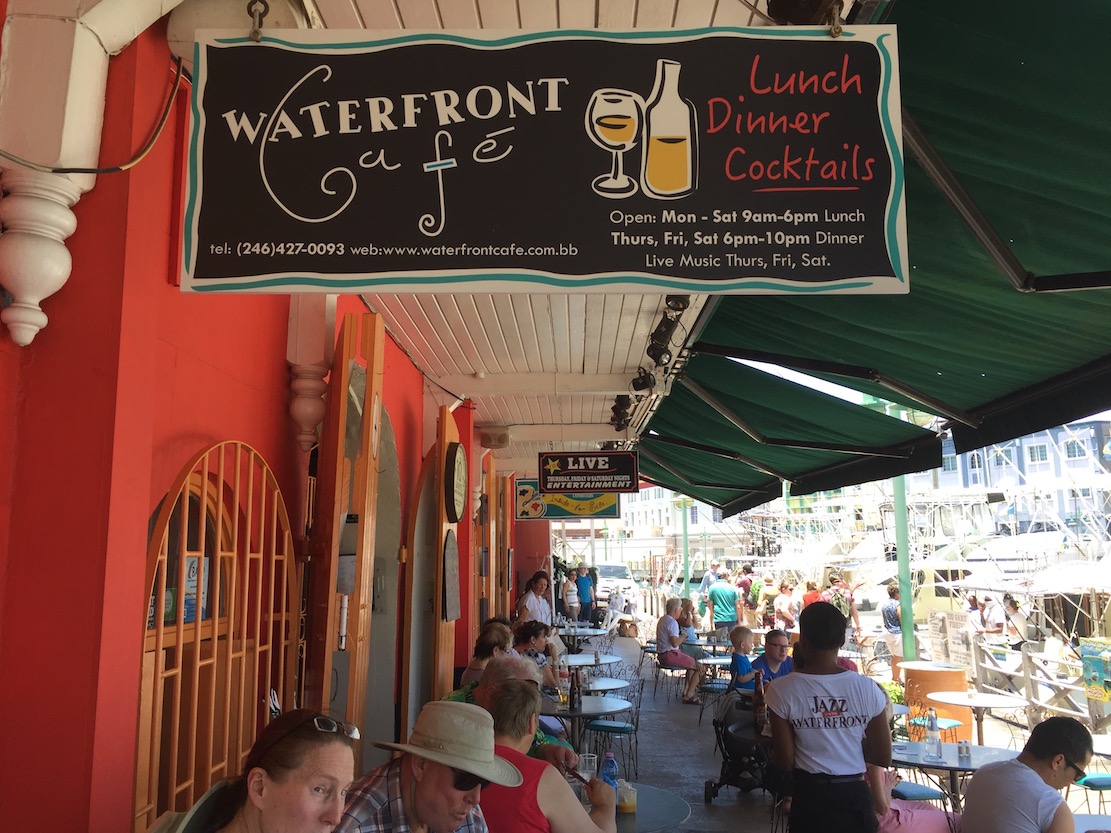
The Careenage, Bridgetown
246-427-0093
My
last meal in Barbados was appropriately on the
marina in Bridgetown, giving me a final
appreciation of the island’s history. Opened
in 1984 by Sue Walcott, who is still a real
presence here, this is a place to settle in or,
better, outside, for a round or two of rum punch,
check out the island artwork for sale, then order
for the group at your table, sharing dishes like
the crisp Bajan salt cod cakes ($26), a ceviche of
kingfish marinated in lime, cucumber, onion and
sweet pepper ($30), or one of the “melts” made of
fish roe that is breaded and fried ($30).
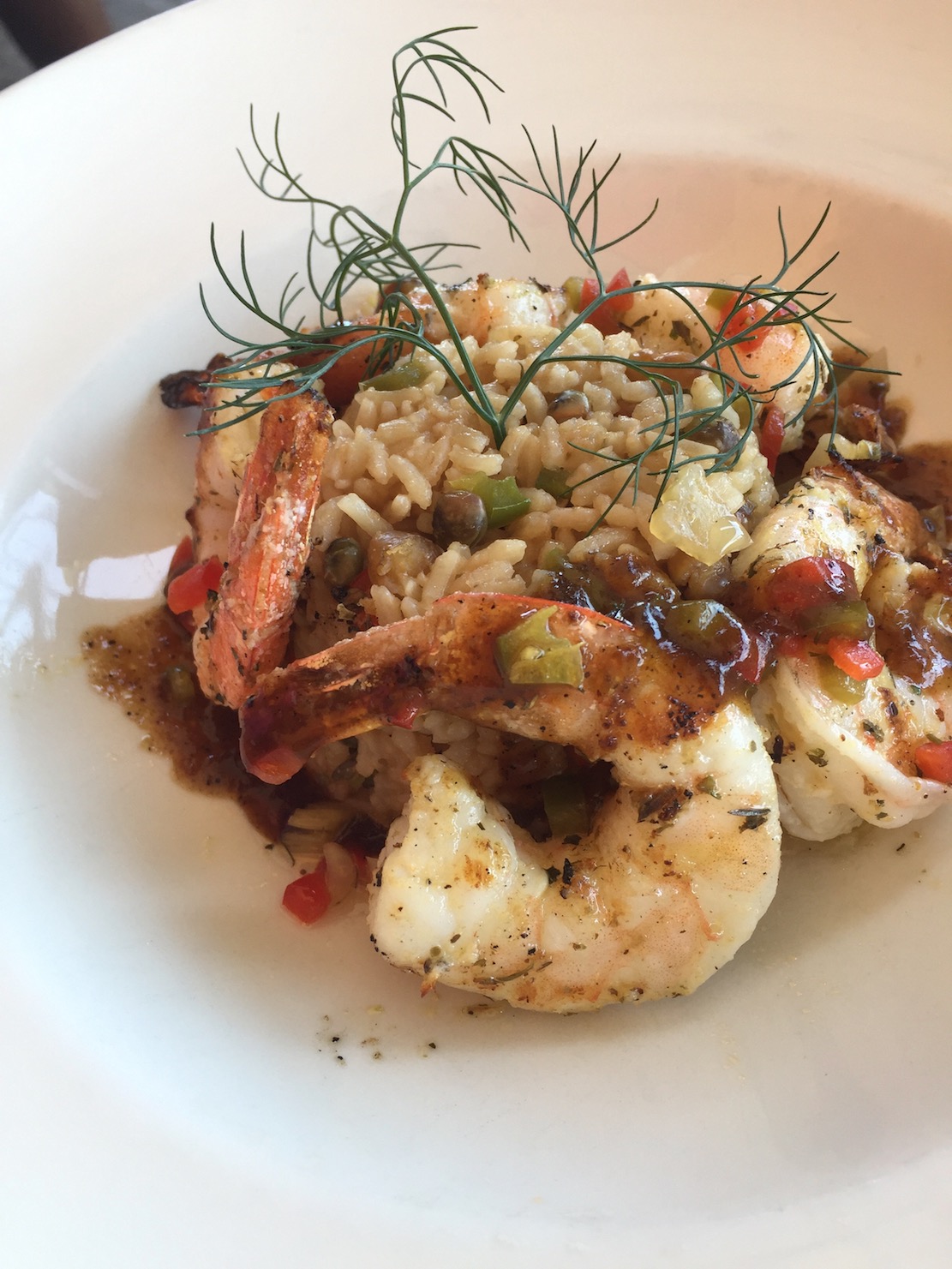 This is far more traditional fare
than at the resorts, where you also won’t find the
national dish—flying fish and cou-cou ($54), a big
plate of three steamed fillets in a Creole broth
served with fried plantain and cucumber pickle
($54), or slow roasted pork shoulder glaze with a
fennel jus
served with sweet potato mash and vegetables
($60).
This is far more traditional fare
than at the resorts, where you also won’t find the
national dish—flying fish and cou-cou ($54), a big
plate of three steamed fillets in a Creole broth
served with fried plantain and cucumber pickle
($54), or slow roasted pork shoulder glaze with a
fennel jus
served with sweet potato mash and vegetables
($60).
The wine list is minimal, but the
Waterfront Connection cocktail of rum, piña
colada, Galliano, white crème de cacao and orange
will make you forget that lapse.
The Waterfront Café is a good introduction
to Barbados local food, but it’s just as good a
place to say goodbye to the island with the memory
of its food culture logged into your fondest
memories.
Live entertainment
Thursday, Friday and Saturday.
❖❖❖
By John Mariani
41 West 42nd Street
212-257-5826
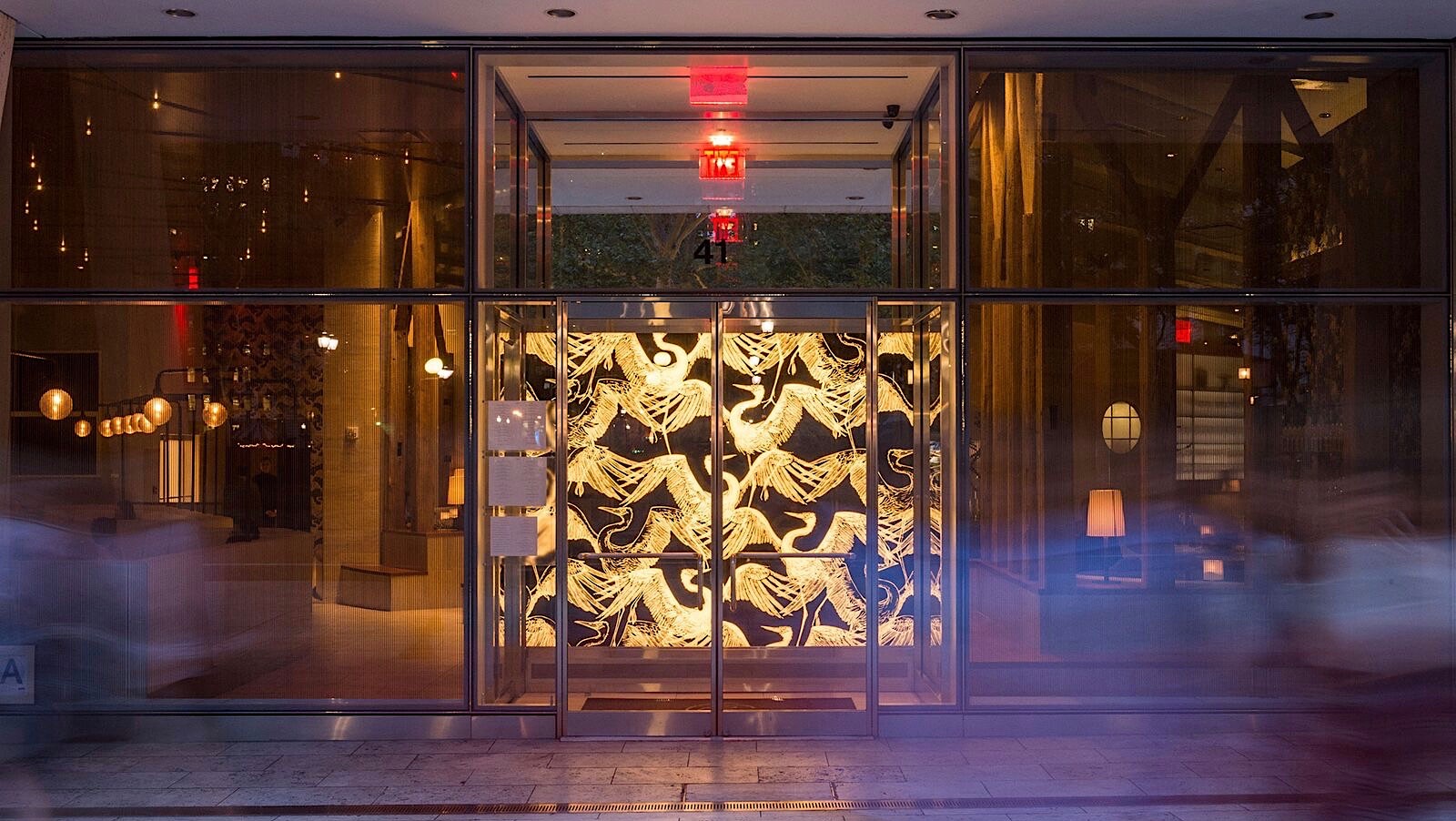
When
Gabriel Kreuther opened his namesake restaurant
across from the New York Public Library on 42nd
Street in 2015, the food media were busy
declaring fine dining—especially French fine
dining—to be dying a slow death.
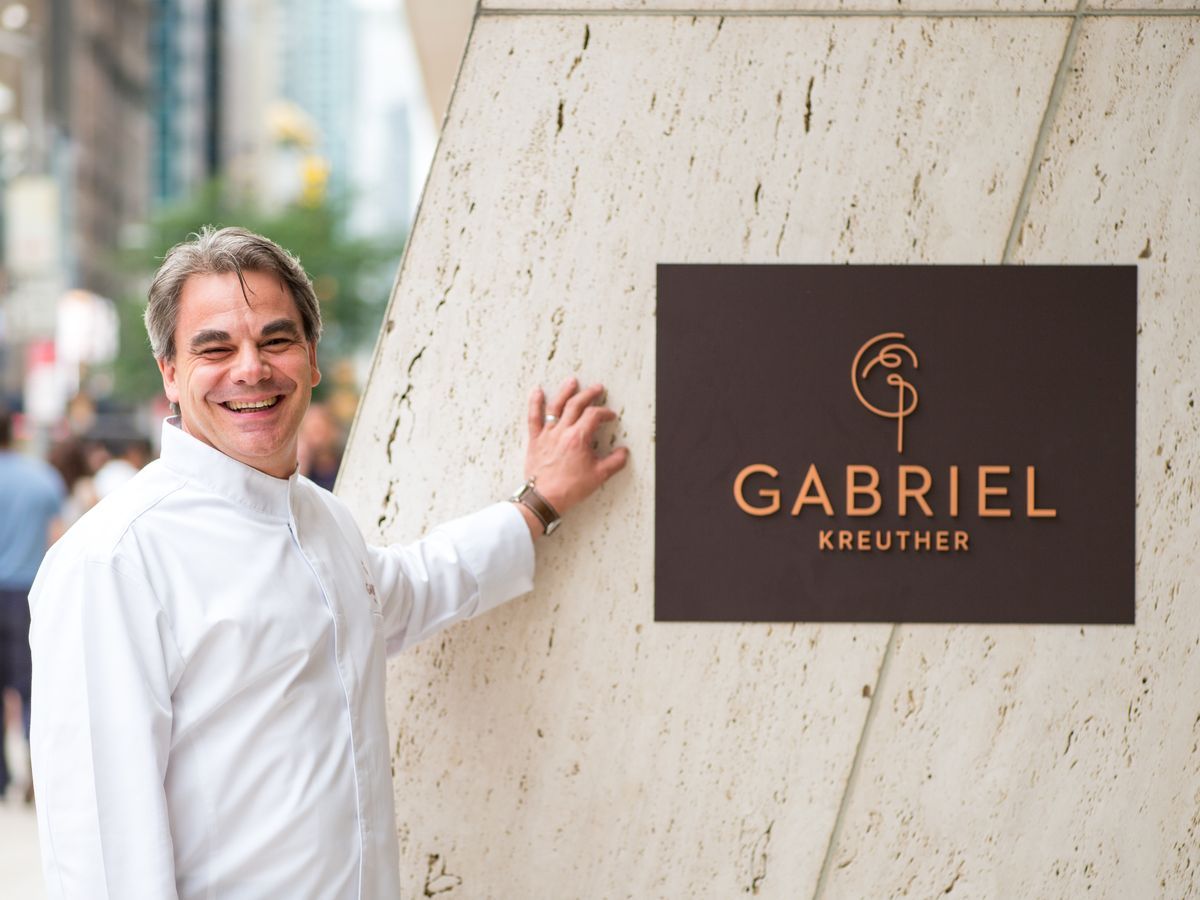 Of course,
there were plenty of New York restaurants to
disprove such a notion—Le Bernardin, Per Se, The
Modern, Nomad, La Grenouille, and others—but
Gabriel Kreuther was to serve as a reminder that
fine dining both thrives and evolves in wonderful
ways and in numerous styles.
Of course,
there were plenty of New York restaurants to
disprove such a notion—Le Bernardin, Per Se, The
Modern, Nomad, La Grenouille, and others—but
Gabriel Kreuther was to serve as a reminder that
fine dining both thrives and evolves in wonderful
ways and in numerous styles.
In Kreuther’s case it was a shift away from his
previous work at Jean-Georges and at The Modern,
for at this new restaurant with his name on the
door he was able fully to showcase his proud
Alsatian heritage, not by merely serving up hearty
platters of choucroute, baeckeoffe and coq au
Riesling, but by using the traditions and
flavors of his region to express his personality
in what have become signature dishes always on the
menu. 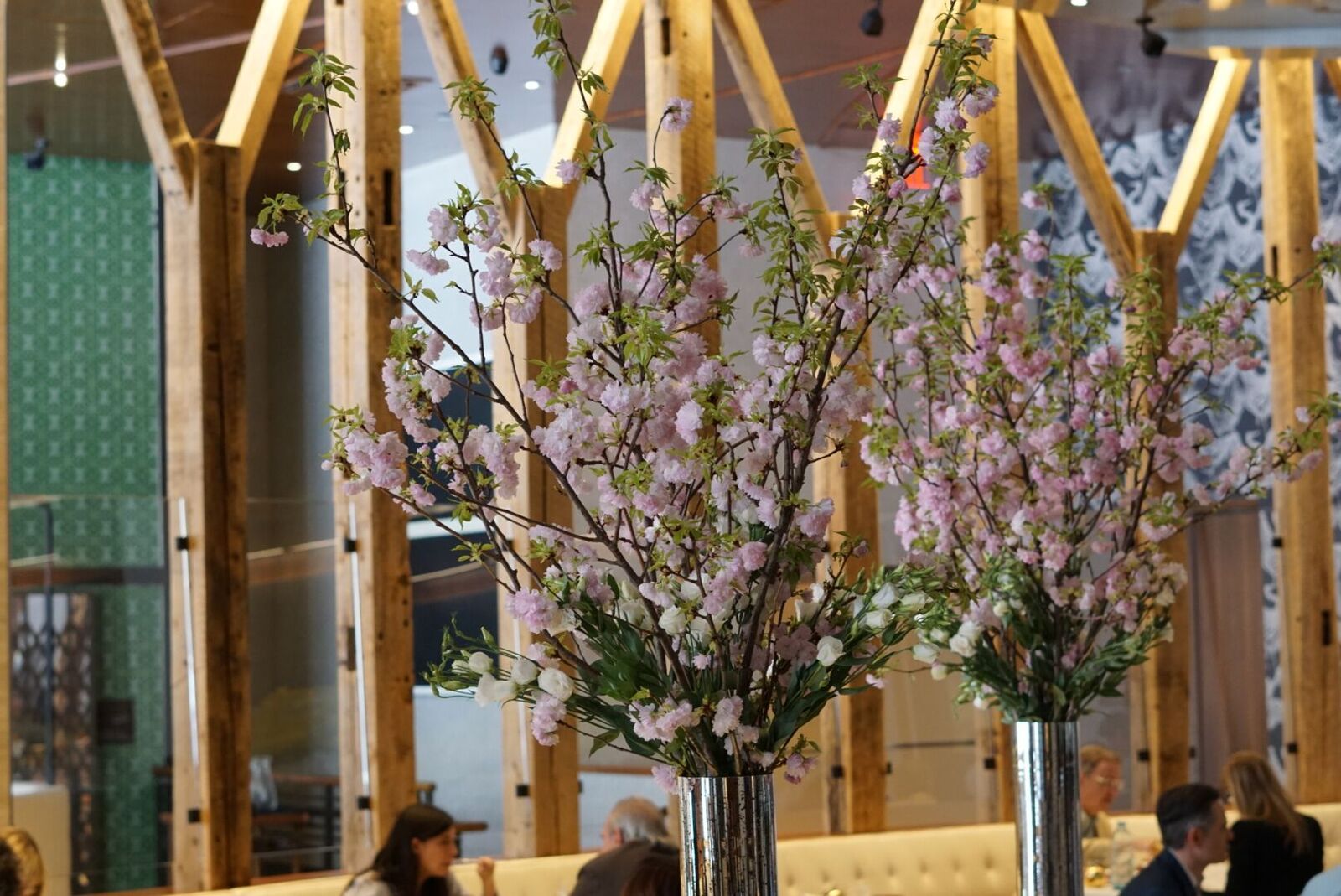
Three years later, now with a new handcrafted chocolate shop adjacent to the restaurant, tables are still full at lunch and dinner, including at the bar, where everyone orders the Alsatian tartes flambées. And Kreuther, along with chef de cuisine Joe Anthony and patîssier Marc Aumont, is cooking better than ever, with more complexity yet wonderfully subtle, as in a velouté of smoked eel with seven grain tuile, saffron tapioca and black truffle coulis, which was my favorite dish of a recent evening, though it didn’t sound very promising because I thought the intensity of such flavors would conflict and confuse. Yet every ingredient was used to produced a perfect harmony of luxurious flavors and textures on the tongue.
GK’s flowing dining spaces, including a chef’s
table near the kitchen, are inspired by town
squares in Alsace, with street lamp light
fixtures, huge wooden beams; a glass wall is
etched with stork imagery, the retro-style
chairs are extremely comfortable and the
lamp-lighted tables are set with thick white
linens and napkins, so the acoustics make for
very civilized conversation. The elongated and
awkward silverware still strikes me as more apt
for a fondue set.
Right from the selection of amuses,
the range of GK’s kitchen was revealed in a light,
flakey pierogie
with spinach and blue Cabrales cheese, and the
most popular item from the bar menu, a flatbread
with cashew hummus and watercress salsa verde. Even a
marinated kale salad
with mustard, hazelnut and kumquat won me over
to that trendy cabbage.
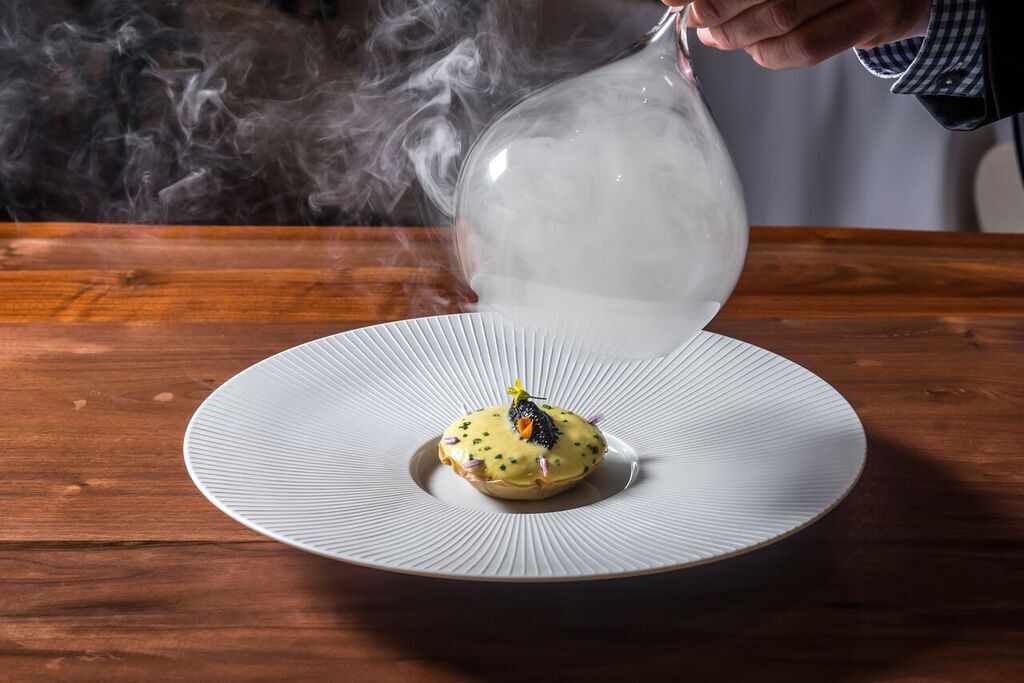 GK is
not unusual in offering a selection of breads, but
here they do it by the course, so with our
appetizers we enjoyed savory Alsatian Kougelhoupf
with softly whipped chive fromage blanc, then
whole grain ficelle
with cultured butter, and with the main course
rosemary buckwheat rolls
with whipped pork lardo
and spices.
GK is
not unusual in offering a selection of breads, but
here they do it by the course, so with our
appetizers we enjoyed savory Alsatian Kougelhoupf
with softly whipped chive fromage blanc, then
whole grain ficelle
with cultured butter, and with the main course
rosemary buckwheat rolls
with whipped pork lardo
and spices.
The first of our four courses was one that has
become a signature item, the applewood smoked
sturgeon and sauerkraut tart with a light
mousseline topped with American caviar (left), a
marriage that really explains everything about
Kreuther’s refinement of traditional ideas. A
velvety foie gras terrine with pistachio praline
came with Medjool date jam, a dash of Strega
liqueur and fennel pollen waffles. Fresh foie gras
of first-rate quality was quickly seared and
spiced with mustard seeds, pickled turnip for
tang, and a sweet pearl onion marmalade. 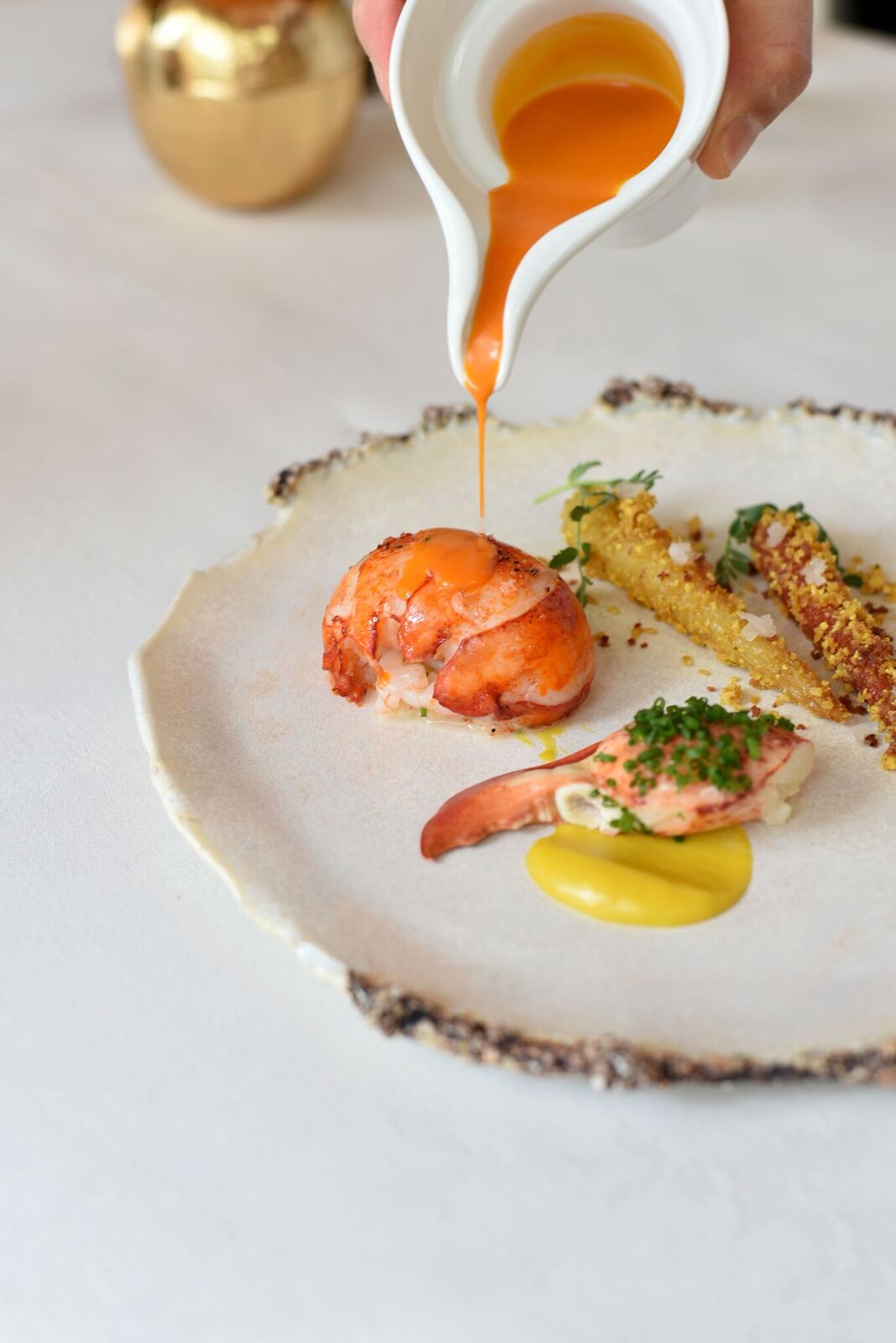 There is
always a raw seafood dish on the menu, that night
subtly flavorful pressed hamachi.
There is
always a raw seafood dish on the menu, that night
subtly flavorful pressed hamachi.
Charcoal grilled lobster, with tomato confit, the
aroma of eucalyptus and artichoke ravioli (right), was
much simpler but very good, and squab served “en cassoulet”
showed how impeccably the kitchen can turn out a
tender, juicy bird, accompanied by kohlrabi
choucroute, coco beans and the surprise of duck
sausage.
Given the excellence of all ingredients on the
menu, it is surprising GK serves Australian lamb
(for two) when it is no match for the best
American lamb.
Desserts lived up to their billing—“Decadent” with
a “mixed media” crumble, chocolate mousse and
caramel ice cream, while “Crisp” (below)
involved an apple-vanilla parfait, pineapple
sphere and herb sorbet.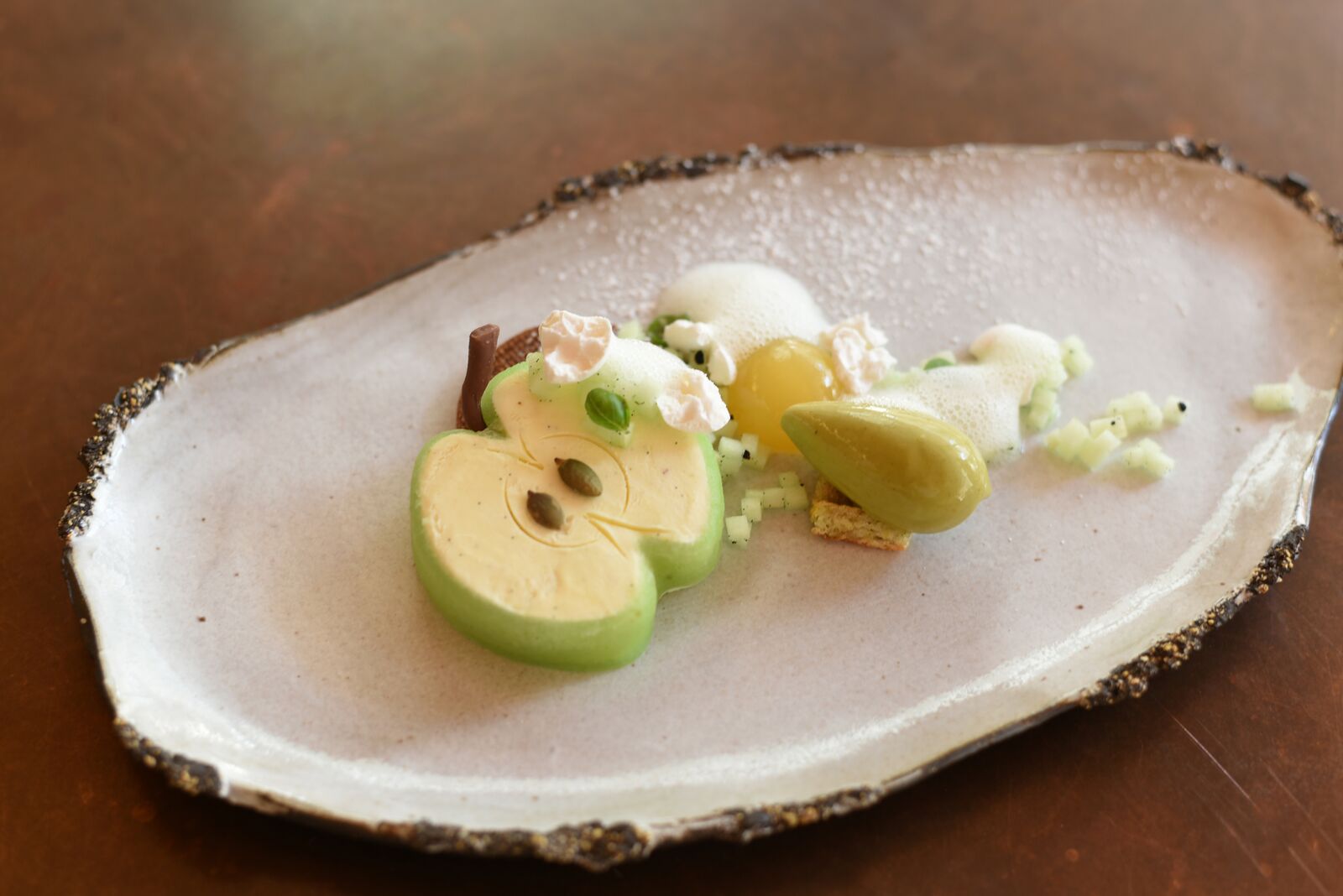 And, of
course, you finish off with GK’s gorgeously rich
chocolates, filled with unexpected flavors.
And, of
course, you finish off with GK’s gorgeously rich
chocolates, filled with unexpected flavors.
Head
sommelier Philippe Sauriat features about 1,500
unique selections on a list that ranks with the
best in NYC.
Of course, there are plenty of Alsatian
bottlings, along with three ciders and a slew of
half-bottles and dozens of Champagnes. There’s
little on the list below $100, however.
At GK you will have one of NYC’s finest dining
experiences, beaming with elegance from the moment
you set foot within its expansive dining room. And
in Gabriel Kreuther you have a master chef who is
cooking at his personal best, buoyed by a kitchen
and service staff of young professionals dedicated
to his unique vision of modern gastronomy.
Prices
for the four-course prix fixe dinner have angled
upward since opening, now $155, though
supplement prices have vanished. Options are a
seven-course dinner at $195 and nine courses at
$235. Lunch, depending on the number of courses,
runs $68-$87.
Open for
lunch Mon.-Fri., for dinner Mon.-Sat.
❖❖❖
Irish
Whiskey Sales Soar Well Beyond
St. Patrick’s Day Celebrations
By John Mariani
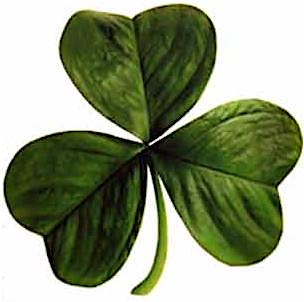
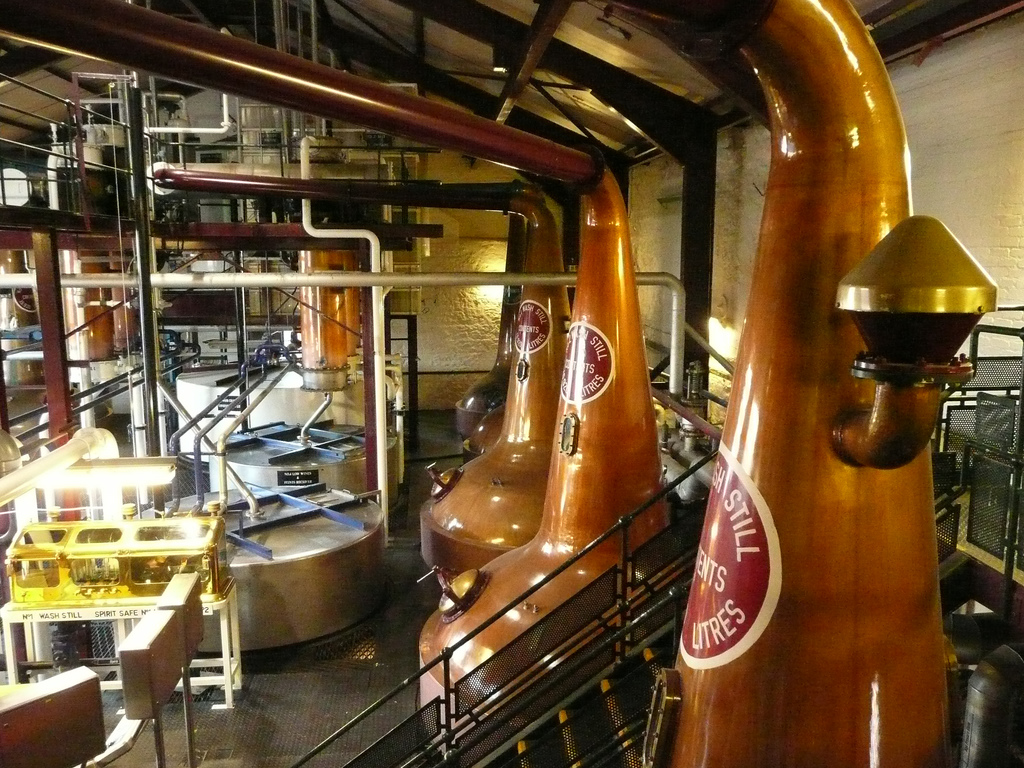
Bushmills
While selections of Single Malt Scotches may still get the most space on the priciest restaurants’ liquor lists, Irish whiskeys are cutting into their market share, with almost 20% annual growth in exports. According to a report by the Irish Food Board, last year’s sales were about $830 million. Top markets are the U.S., the U.K., Canada, Germany and France. The Japanese market was the best performing of the Asian countries, with sales rising by 30 percent to $9 million. The Irish drink up about 6 million bottles on their own.
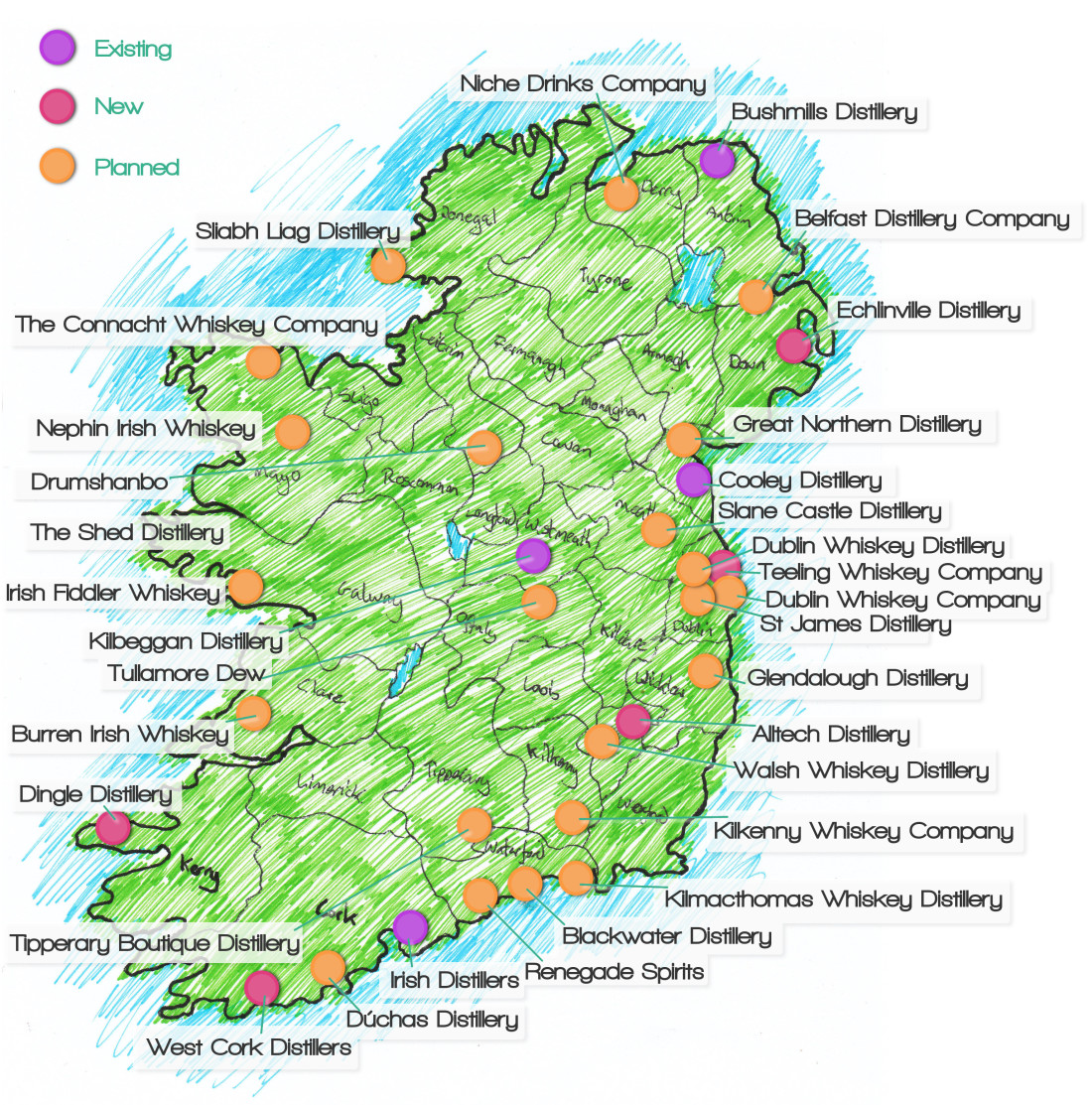 Such
success
is clearly not just the luck of the Irish. The
country’s whiskey
industry has been canny about both marketing and
promotion, and just last month
the Alcohol Beverage Federation of Ireland, the
representative body for drinks
manufacturers and suppliers in Ireland, welcomed
the progression of the
Breweries and Distilleries Bill, which will
allow craft brewers and distillers
to sell their produce onsite to visitors, which
in turn they believe will
increase tourism to Ireland.
Such
success
is clearly not just the luck of the Irish. The
country’s whiskey
industry has been canny about both marketing and
promotion, and just last month
the Alcohol Beverage Federation of Ireland, the
representative body for drinks
manufacturers and suppliers in Ireland, welcomed
the progression of the
Breweries and Distilleries Bill, which will
allow craft brewers and distillers
to sell their produce onsite to visitors, which
in turn they believe will
increase tourism to Ireland.
This is in contrast to 30 years ago, when Pernod Ricard bought Irish Distillers, which was then selling less than half a million cases a year. As of 2016 those sales had soared to 2.83 million nine-liter cases of Jameson Irish Whiskey alone.
“Irish” is a grain whiskey, mostly blended, though there are also Single Malt, Single Grain, and Pure Pot Still styles. Unlike Scotch, Irish does not use peat in its malting process (exceptions include Tullamore and Connemara Peated Malt), so there is less smokiness in the bottle.
In the late
19th century more than 150 distilleries produced
more than 400 different brands
of Irish, but the industry was crippled by the
onset of Prohibition in the
U.S. Weak
grain supplies and lack
of marketing money stifled sales, which abroad
were a niche market among
Irish-Americans at a time when most Americans
drank other “brown goods” like
bourbon, rum, rye, Canadian, and Scotch.
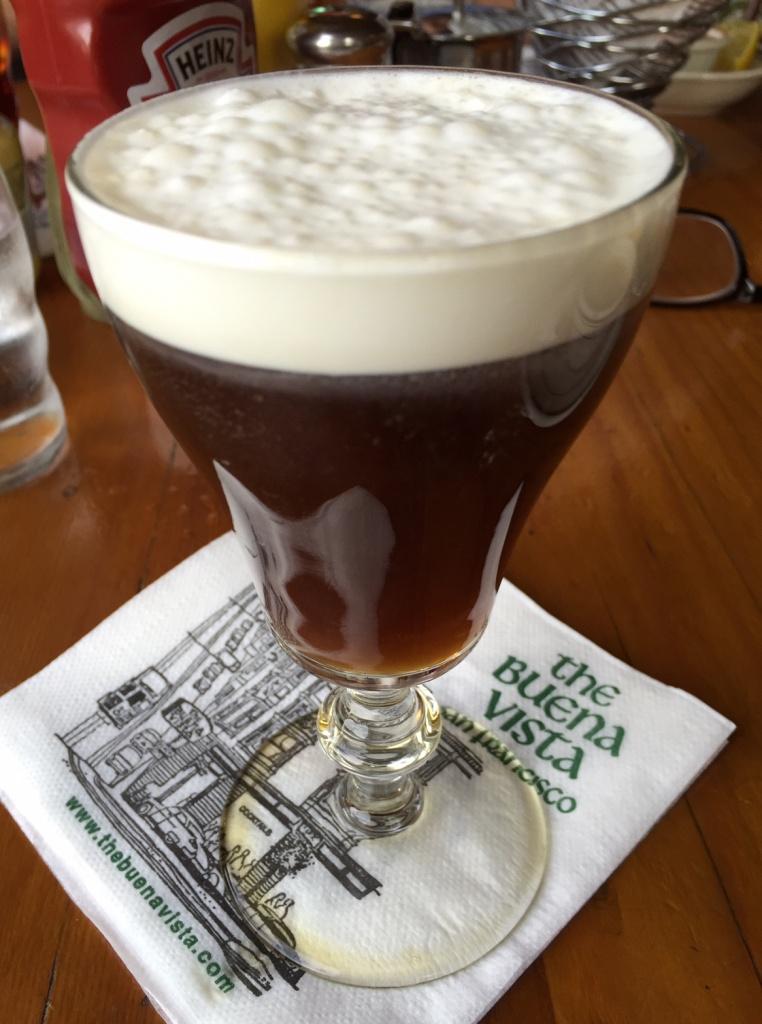
The promotion of Irish coffee, created as a welcoming drink at Irish airports in the 1950s, was boosted by American newsman Stan Delaplane when he featured it at San Francisco’s Buena Vista Bar, where a plaque outside tells the story. Ever since it’s been a huge factor in Irish whiskey sales.
As recently as 2011 there were just three distilleries in Ireland making all the brands’ whiskies. Today there are 18, with 16 more planned. This has resulted in fierce competition among new producers looking for their own niche in the expanding small-batch market, with the kind of novel claims Scotch producers began making in the 1980s.
Some are sold exclusively at The Irish Whiskey Collection at Dublin Airport. Cooley’s makes a “Single Cask” and a “Cask Strength.” Knappogue Castle makes a 16-year-old "Twin Wood" single malt aged in old bourbon casks, followed by nine months in oloroso sherry butts, as well as a Master Distiller’s Private Selection vintage. Midleton bottles its “Very Rare.” Michael Collins is a bottling named after the beloved Irish political leader played by Liam Neeson in a 1996 biopic. Some producers have even tried flavoring their whiskies with spices and citrus. Many of these oddities are sold only at Dublin’s airport; some are sold only in the U.S.
 Bushmills
still dominates the market, with Jameson next (left), but
the newcomers are gaining
ground. Prices for Irish whiskey, even for the
best of them, used to be well
under $40 a bottle—there are still fine ones to
be had for $25—but some new
entries in the market can match those of premium
Scotches and Cognacs. Today,
prestigious small-batch labels cost upwards of
$200.
Bushmills
still dominates the market, with Jameson next (left), but
the newcomers are gaining
ground. Prices for Irish whiskey, even for the
best of them, used to be well
under $40 a bottle—there are still fine ones to
be had for $25—but some new
entries in the market can match those of premium
Scotches and Cognacs. Today,
prestigious small-batch labels cost upwards of
$200.
Among
the newer ones in the market I’ve been impressed
by Tullamore Dew’s good basic
label, a 12-Year-Old ($30).
Cooley’s Connemara now makes four small-
batch whiskies, including a
12-Year-Old Peated Single Malt ($72-$90) and the
heavily peated Turf Mor labels
($55). Midleton Very Rare ($140), arriving in an
elegant oak box and labeled
“Supreme Selection,” is deliciously complex.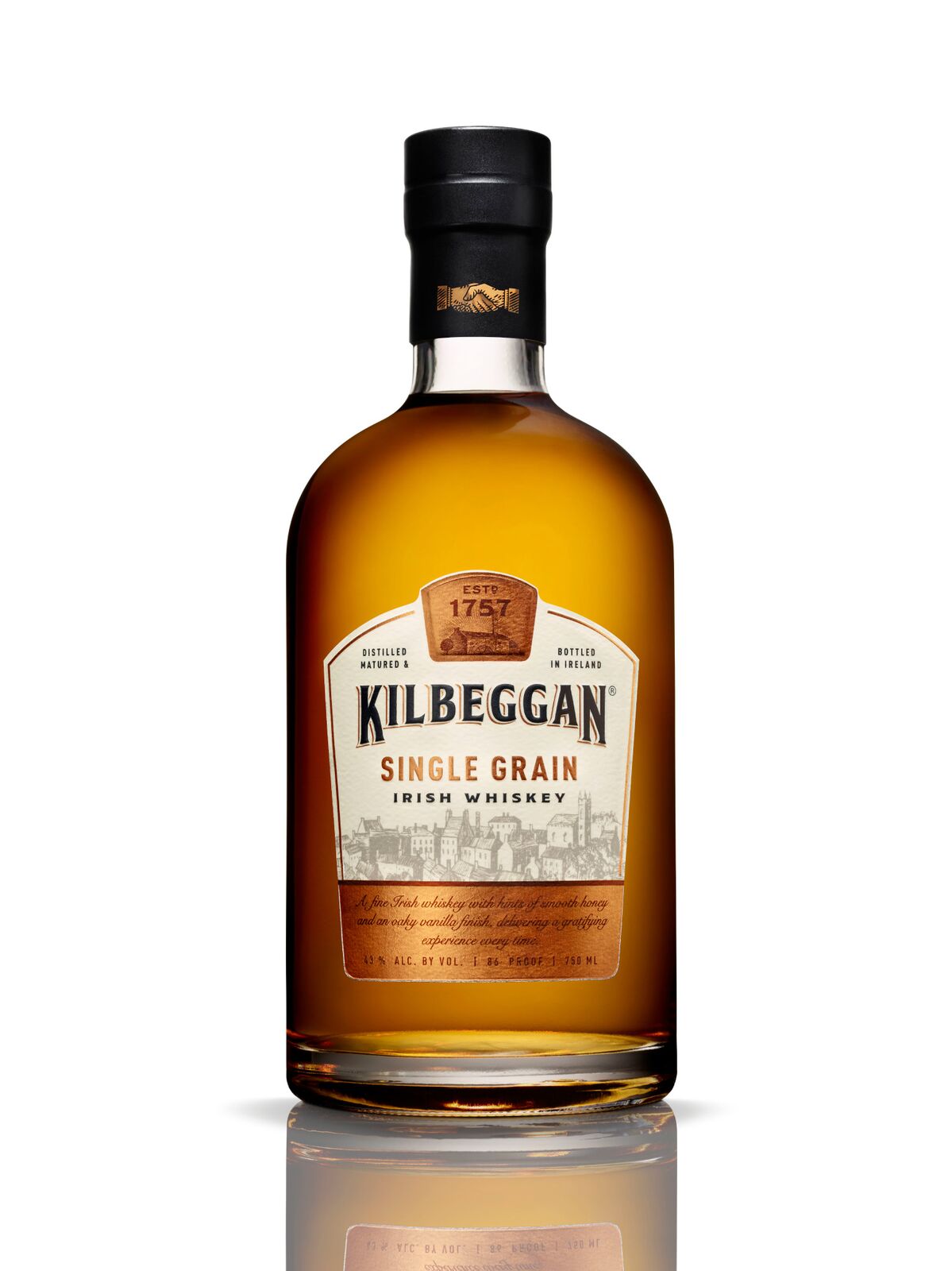
Bushmills’s standard “White Label” ($19), once the favorite of Czar Peter the Great, is still a fine intro to the spirit, and its malty Black Bush ($24), aged in old sherry casks, has long been a big seller in the U.S. Their 10-Year-Old Single Malt ($40), matured in bourbon barrels for at least 10 years, has a lively smokiness in the bouquet, with level after level of complex spices and fruit, finishing like velvet on the back of the throat. The 16-Year-Old ($25) is a brawnier whiskey, quite nutty, with a dark chocolate and dried fruit component.
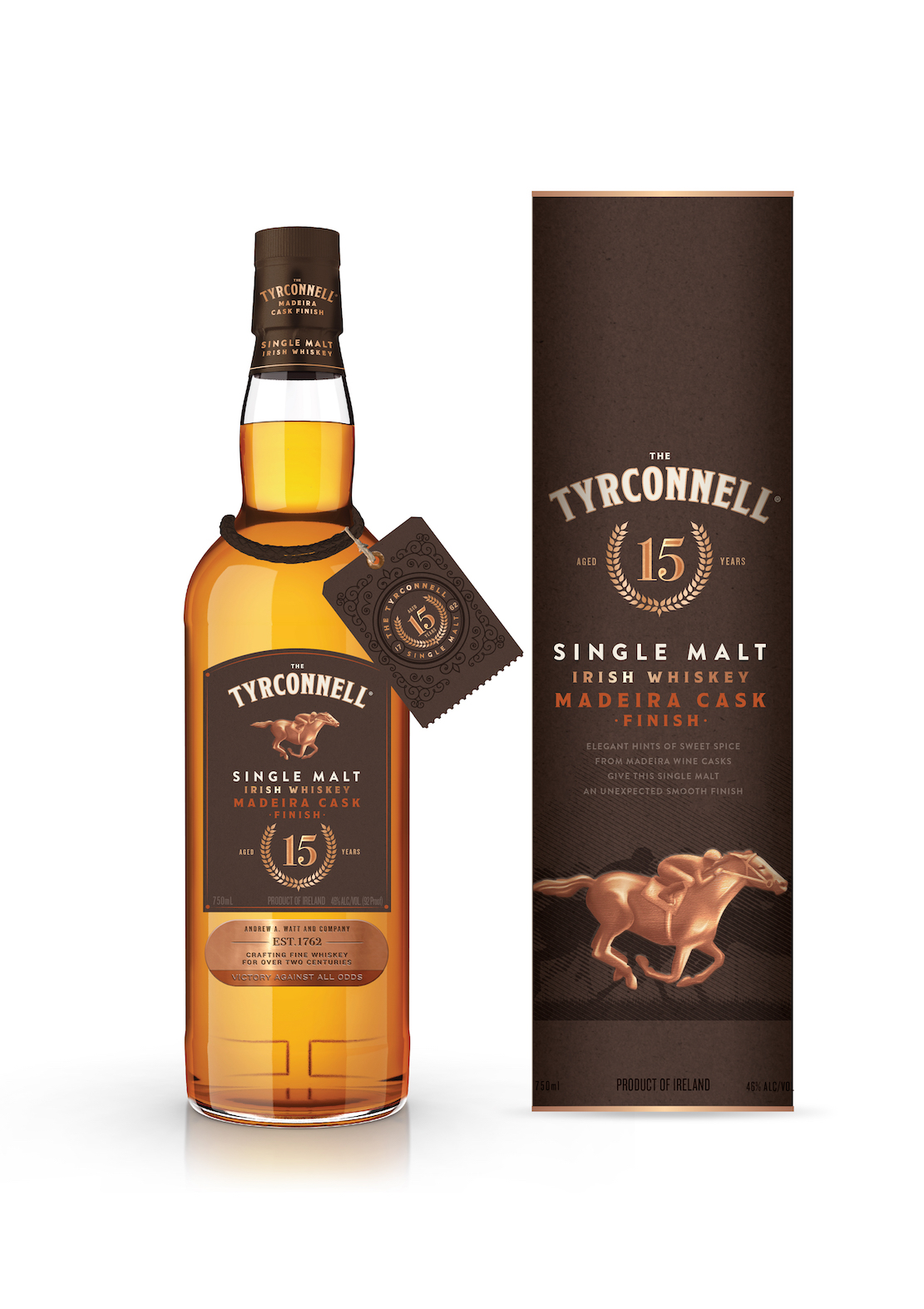 Kilbeggan
Single Grain Irish Whiskey
($29.99), just released this month, refers to a
whiskey made in a single
location using malted barley and at least one
other grain, in this case 94%
corn plus 6% malted barley and distilled at 86
proof, aged in bourbon barrels. That corn
component adds a light and pretty
sweetness that evokes bourbon, and the finish
is very smooth, with light
tannins.
Kilbeggan
Single Grain Irish Whiskey
($29.99), just released this month, refers to a
whiskey made in a single
location using malted barley and at least one
other grain, in this case 94%
corn plus 6% malted barley and distilled at 86
proof, aged in bourbon barrels. That corn
component adds a light and pretty
sweetness that evokes bourbon, and the finish
is very smooth, with light
tannins.
Tyrconnell has also just released to select U.S. markets a 15-Year-Old Madeira Cask Finish Single Malt Irish Whiskey ($100) aged for 15 years in American White Oak ex-bourbon barrels then finished in Madeira wine casks, making it the oldest Madeira cask finished Tyrconnell has released. They also do Pork cask and Sherry cask expressions of Irish whiskey. The spirit is made of just two ingredients: Irish barley and spring water, utilizing double distillation (46% alcohol), which sustains richer flavors. It has an enchanting spicy nose that follows through with a bite of heat, then piney notes and Madeira sweetness.
❖❖❖

STRIKE UP THE BAND!
“Sen Sakana’s best dishes refuse to sit still. The
mostly small plates are laced with vigorous
flavors that dance, bounce and surprise.”—Daniel
Meyer, “Sen Sakana,” TimeOut New
York (9/27/17)
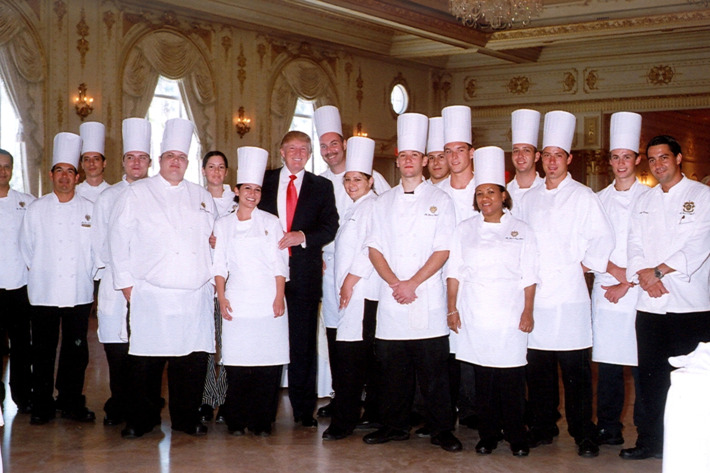
Donald Trump’s Mar-a-Lago Club in Palm
Beach, whose members pay $200,000, was found
in violation of 15 health regulations in its
kitchen, including a failure to properly track the
freshness of some foods; curry sauce that
reportedly had a use-by date of October 21, which
was allegedly improperly marked and in the freezer
during the November inspection; milk stored at 49
degrees instead of 41 degrees, and cases of hot
dogs reportedly found being stored on the ground
in the walk-in freezer. Still, the kitchen passed
inspection.
Wine Column Sponsored by Banfi Vintners
SANGIOVESE
Wine is a joy year-round but in
cooler weather one grape varietal has
really taken center stage in my daily
activities – that most Italian of grapes, Sangiovese,
and its ultimate
expression – Brunello di Montalcino.
From mid-September
through mid-October, the Sangiovese grown for our
various styles of red wines are
be harvested, culminating with the top selection for
Brunello di Montalcino.
Second, cooler weather here means it is
time to start enjoying more red wines and especially
Sangiovese based
wines. That
includes Banfi’s cru
of Brunello, Poggio alle Mura, literally the cream of
the crop of our
Sangiovese vineyards. Alongside our Poggio alle Mura
Brunello di Montalcino,
this year we introduced two more wines from the cru
Poggio alle Mura – a Rosso
di Montalcino and a Riserva of Brunello.
Rosso is sort of like the younger brother of
Brunello, also made from
100% Sangiovese grapes but usually a selection from
younger vines and the wine
is aged only two years compared to the four required
for Brunello. The
Riserva, on the other hand, is an
even more selective harvest of Sangiovese, and ages
for an additional year
before release.
What
is so special about this cru Poggio
alle Mura? Well,
it is the result
our over 30 years of ongoing research at my family’s
vineyard estate, Castello
Banfi. When
we first began
planting our vines there in the late 1970s studies
from the University of
Bordeaux indicated which strains of many varietals we
should plant, based on
the soil type and microclimate of each vineyard. But when it came to the region’s
native Sangiovese, there
was only local lore, no scientific research. So we took it upon ourselves to
figure out this vine, and
set off on three decades of incredibly detailed
research.
We
started with 600 apparent variations
on Sangiovese, because it is so susceptible to
variations in weather and soil,
and narrowed that down to 160 truly genetically
different clones.
We planted a vineyard with two rows of
each type, made wine from each of them, and charted
the differences – remember,
you only get one chance a year to make wine, so this
took time.
It
took about ten years to get some
concrete results, though we continue to experiment
today and always will – you
never stop learning in science and nature! Once we determined which were
the best, complementary clones
that could be planted together to make the best
Brunello, we chose to plant
them in what we determined to be the optimal vineyard
sites. Coincidentally,
the best soils and
climate conditions are in the slopes surrounding the
medieval fortress today
known as Castello Banfi, known since Etruscan times as
Poggio alle Mura – the
walled hilltop.
Hence the name of
our most special “cru” of Brunello, representing a
synthesis between tradition
and innovation.
Though
the focus of this study was our
Brunello, all of our Sangiovese-based wines, including
the super Tuscans
SummuS, Cum Laude, and Centine, benefitted from this
work. And
that’s the third reason for
celebrating Sangiovese this month, for the range of
wonderful reds that usher
us into autumn!
One wine in
particular was inspired by our research – the BelnerO,
a Sangiovese dominant
blend with what I like to call a kiss of Cabernet and
a whisper of Merlot.
We grow the grapes a little differently
for BelnerO than for Brunello, make the wine with less
oak aging and released
it earlier from the winery, providing a counterpoint
to Brunello and a lovely
terroir-driven wine in its own right.
If you know Italians, you know that by nature
we are multi-faceted,
varying in mood, and always passionate.
As a nation, we span from the hot sunny beaches
of Sicily near the
African coast to the rugged mountains and Alpine ski
slopes of Trentino-Alto
Adige in the north.
Sangiovese is
grown in almost all of Italy’s regions and reflects
the unique nature of each;
it is most famous (rightfully so) in Tuscany, yet even
there it reflects the
nuances of each hilltop, valley and subzone. It has something a little
different to say in Brunello than
Chianti, Morellino than Vino Nobile di Montepulciano,
Rosso di Montalcino than
Super Tuscan blends.
Here
is a smattering of Sangiovese-based
wines that you may wish to get to know better,
reflecting a spectrum that
appeals to every occasion, every taste, and every
budget. We
can assure you that the conversation
will never become boring.
Recommendations for
Celebrating Sangiovese
BelnerO Proprietor’s
Reserve Sangiovese – A refined
cuvée of noble red grapes
perfected by our pioneering clonal research. This dark
beauty, BelnerO, is
produced at our innovative winery, chosen 11
consecutive years as Italy’s
Premier Vineyard Estate. Fermented in our patented
temperature controlled
French oak and aged approximately 2 additional years.
Unfiltered, and Nitrogen
bottled to minimize sulfites.
Castello Banfi
Brunello di Montalcino – Rich, round, velvety
and intensely aromatic, with flavor hints of licorice,
cherry, and spices.
Brunello di Montalcino possesses an intense ruby-red
color, and a depth,
complexity and opulence that is softened by an
elegant, lingering aftertaste.
Unfiltered after 1998 vintage.
Castello Banfi Rosso
di Montalcino – Brunello's "younger
brother," produced from select
Sangiovese grapes and aged in barrique for 10 to 12
months. Deep ruby-red,
elegant, vibrant, well-balanced and stylish with a dry
velvety finish.
Poggio all’Oro
Brunello di Montalcino Riserva – A single
vineyard selection of our most historically
outstanding Sangiovese, aged five
years before release, the additional year more than
that required of Brunello
including 6 months in barrel and 6 months more in
bottle to grant its “Riserva”
designation. Incredible
elegance
and harmony. Intense with lots of fruit and subtle
wood influence. Round,
complete, well balanced with hints of chocolate and
berries. Unfiltered after
1998.
Poggio alle Mura – The first tangible result
of years of intensive clonal research
on Montalcino’s native Sangiovese grape.
Estate bottled from the splendidly sun drenched
vineyards surrounding
the medieval Castello from which it takes its name. The Brunello di
Montalcino is seductive, silky and smoky. Deep ruby in color with an
expressive bouquet of violets,
fruits and berries as well as cigar box, cedar and
exotic spices. The Rosso di
Montalcino is also intense
ruby red. The
bouquet is fresh and
fruity with typical varietal notes of cherry and
blackberry, enriched by more
complex hints of licorice, tobacco and hazelnut. It is full bodied, yet with a
soft structure, and a
surprisingly long finish. The Poggio
alle Mura Brunello di Montalcino Riserva is
deep ruby red with garnet
reflections and a rich, ample bouquet that hints of
prune jam, coffee, cacao
and a light balsamic note. It is
full and powerful, with ripe and gentle tannins that
make it velvety and
harmonious; this wine is supported by a pleasing
minerality that to me speaks
soundly of that special hillside in southern
Montalcino.
SummuS – A wine of
towering elegance, SummuS is an extraordinary blend of
Sangiovese which
contributes body; Cabernet Sauvignon for fruit and
structure; and Syrah for
elegance, character and a fruity bouquet.
An elegant, complex and harmonious red
wine.
Cum Laude – A complex
and elegant red which graduated “With Honors,”
characterized by aromas of juicy
berries and fresh spices.
Centine – A Cuvee
that is more than half Sangiovese, the balanced
consisting of equal parts of
Cabernet Sauvignon and Merlot.
Vinified in a firm, round style that easily
accompanies a wide range of
dishes, this is a smooth and fragrantly satisfying
wine with international
character, and a perennial favorite at my own dinner
table.
Banfi Chianti Superiore
– The
“Superiore” designation signifies stricter government
regulations regarding
production and aging requirements, as compared to
regular Chianti.
An intense ruby red wine with fruit
forward aromas and floral notes.
This is a round wine with well-balanced acidity
and fruit.
Banfi Chianti Classico
– An
enduring classic: alluring bouquet of black fruit
and violets; rich flavors
of cherry and leather; supple tannins and good acidity
for dining.
Banfi Chianti Classico
Riserva – Produced
from select grapes grown in
the "Classico" region of Chianti, this dry, fruity and
well-balanced
red has a full bouquet reminiscent of violets.
Fonte alla Selva
Chianti Classico – This is our newest entry
into the Chianti arena, coming from
a 99 acre estate in Castellina, the heart of the
Chianti Classico region. The wine is a captivating mauve
red
that smells of cherry, plum and blackberry with hints
of spice. It
is round, full and balanced with
very good acidity.
Col di Sasso – Sangiovese
and Cabernet Sauvignon.
Luscious,
complex and soft with persistent notes of fruit and
great Italian style
structure.
Any of John Mariani's books below may be ordered from amazon.com.
 The Hound in Heaven
(21st Century Lion Books) is a novella, and
for anyone who loves dogs, Christmas, romance,
inspiration, even the supernatural, I hope you'll find
this to be a treasured favorite. The story
concerns how, after a New England teacher, his wife and
their two daughters adopt a stray puppy found in their
barn in northern Maine, their lives seem full of promise.
But when tragedy strikes, their wonderful dog Lazarus and
the spirit of Christmas are the only things that may bring
his master back from the edge of despair.
The Hound in Heaven
(21st Century Lion Books) is a novella, and
for anyone who loves dogs, Christmas, romance,
inspiration, even the supernatural, I hope you'll find
this to be a treasured favorite. The story
concerns how, after a New England teacher, his wife and
their two daughters adopt a stray puppy found in their
barn in northern Maine, their lives seem full of promise.
But when tragedy strikes, their wonderful dog Lazarus and
the spirit of Christmas are the only things that may bring
his master back from the edge of despair. WATCH THE VIDEO!
“What a huge surprise turn this story took! I was completely stunned! I truly enjoyed this book and its message.” – Actress Ali MacGraw
“He had me at Page One. The amount of heart, human insight, soul searching, and deft literary strength that John Mariani pours into this airtight novella is vertigo-inducing. Perhaps ‘wow’ would be the best comment.” – James Dalessandro, author of Bohemian Heart and 1906.
“John Mariani’s Hound in Heaven starts with a well-painted portrayal of an American family, along with the requisite dog. A surprise event flips the action of the novel and captures us for a voyage leading to a hopeful and heart-warming message. A page turning, one sitting read, it’s the perfect antidote for the winter and promotion of holiday celebration.” – Ann Pearlman, author of The Christmas Cookie Club and A Gift for my Sister.
“John Mariani’s concise, achingly beautiful novella pulls a literary rabbit out of a hat – a mash-up of the cosmic and the intimate, the tragic and the heart-warming – a Christmas tale for all ages, and all faiths. Read it to your children, read it to yourself… but read it. Early and often. Highly recommended.” – Jay Bonansinga, New York Times bestselling author of Pinkerton’s War, The Sinking of The Eastland, and The Walking Dead: The Road To Woodbury.
“Amazing things happen when you open your heart to an animal. The Hound in Heaven delivers a powerful story of healing that is forged in the spiritual relationship between a man and his best friend. The book brings a message of hope that can enrich our images of family, love, and loss.” – Dr. Barbara Royal, author of The Royal Treatment.
 |
The Encyclopedia of American Food and Drink by John F. Mariani (Bloomsbury USA, $35) Modesty forbids me to praise my own new book, but let me proudly say that it is an extensive revision of the 4th edition that appeared more than a decade ago, before locavores, molecular cuisine, modernist cuisine, the Food Network and so much more, now included. Word origins have been completely updated, as have per capita consumption and production stats. Most important, for the first time since publication in the 1980s, the book includes more than 100 biographies of Americans who have changed the way we cook, eat and drink -- from Fannie Farmer and Julia Child to Robert Mondavi and Thomas Keller. "This book is amazing! It has entries for everything from `abalone' to `zwieback,' plus more than 500 recipes for classic American dishes and drinks."--Devra First, The Boston Globe. "Much needed in any kitchen library."--Bon Appetit. |
"Eating Italian will never be the same after reading John Mariani's entertaining and savory gastronomical history of the cuisine of Italy and how it won over appetites worldwide. . . . This book is such a tasteful narrative that it will literally make you hungry for Italian food and arouse your appetite for gastronomical history."--Don Oldenburg, USA Today. "Italian
restaurants--some good, some glitzy--far
outnumber their French rivals. Many of
these establishments are zestfully described
in How Italian Food Conquered the World, an
entertaining and fact-filled chronicle by
food-and-wine correspondent John F.
Mariani."--Aram Bakshian Jr., Wall Street
Journal.
"Equal parts
history, sociology, gastronomy, and just
plain fun, How Italian Food Conquered the
World tells the captivating and delicious
story of the (let's face it) everybody's
favorite cuisine with clarity, verve and
more than one surprise."--Colman Andrews,
editorial director of The Daily
Meal.com. "A fantastic and fascinating
read, covering everything from the influence
of Venice's spice trade to the impact of
Italian immigrants in America and the
evolution of alta cucina. This book will
serve as a terrific resource to anyone
interested in the real story of Italian
food."--Mary Ann Esposito, host of PBS-TV's
Ciao
Italia. "John Mariani has written the
definitive history of how Italians won their
way into our hearts, minds, and
stomachs. It's a story of pleasure over
pomp and taste over technique."--Danny Meyer,
owner of NYC restaurants Union Square
Cafe, The Modern, and Maialino.
|
 |
 |
 |
 |
 |
 |
 |
 |
 Everett Potter's Travel Report:
Everett Potter's Travel Report: 
 Eating Las Vegas
JOHN CURTAS has been covering the Las Vegas
food and restaurant scene since 1995. He is
the co-author of EATING LAS VEGAS – The 50
Essential Restaurants (as well as
the author of the Eating Las Vegas web site: www.eatinglasvegas.
He can also be seen every Friday morning as
the “resident foodie” for Wake Up With the
Wagners on KSNV TV (NBC) Channel 3 in
Las Vegas.
Eating Las Vegas
JOHN CURTAS has been covering the Las Vegas
food and restaurant scene since 1995. He is
the co-author of EATING LAS VEGAS – The 50
Essential Restaurants (as well as
the author of the Eating Las Vegas web site: www.eatinglasvegas.
He can also be seen every Friday morning as
the “resident foodie” for Wake Up With the
Wagners on KSNV TV (NBC) Channel 3 in
Las Vegas.

MARIANI'S VIRTUAL GOURMET
NEWSLETTER is published weekly. Editor/Publisher: John
Mariani.
Editor: Walter Bagley. Contributing Writers: Christopher Mariani,
Robert Mariani, Misha Mariani, John A. Curtas, Geoff Kalish, Mort
Hochstein, and
Brian Freedman. Contributing Photographer: Galina
Dargery. Technical Advisor: Gerry McLoughlin.
If you wish to subscribe to this
newsletter, please click here: http://www.johnmariani.com/subscribe/index.html
© copyright John Mariani 2017

